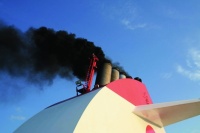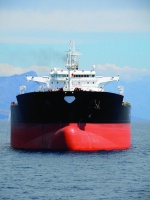
To most people, shipping is the green face of freight transport. While the low-carbon arguments focus on speedy but fuel-hungry, CO2-spewing aircraft, the fleets of container ships and tankers give the impression of patience, slowness and a gentler, low-impact way of moving goods around the world.
Of course, this is not the whole story. While it is true that marine diesel engines are more efficient than jet engines, the actual emissions from shipping are more than twice as high as those from aviation, and they are increasing fast. As much as two years ago, a joint study from BP, which owns a 50-tanker fleet, and the German Institute for Physics and Atmosphere showed that annual emissions from shipping were ranging from 600 million to 800 million tonnes of CO2, around three per cent of the world total, and that they were on track to increase by around 75 per cent in the next 15-20 years. According to the International Maritime Organisation (IMO), annual emissions have now topped a billion tonnes of CO2 and could double or triple by 2050.
While projects such as Denmark’s Green Ship of the Future aim to improve the overall environmental performance of shipping, with scrubbing systems to remove pollutants and modifications to hulls, drive systems and engine performance (see box), Imperial College spin-out Process Systems Enterprise (PSE) is joining forces with maritime classification society Det Norske Veritas (DNV) to develop systems for on-ship carbon capture and storage (CCS).
PSE specialises in the simulations of chemical-industry processes and logistics to optimise and fine-tune the variables to maximise profitability. However, the goal of fitting carbon-capture equipment to marine engines is likely to test it to the full, said Costas Pantelides, PSE’s managing director. ’This is a challenging design problem with tight constraints, and the application of our model-based innovation technology will be key to developing technically feasible and economically viable solutions,’ he added.

DNV is closely involved with the development of carbon-capture systems, but much of its work has focused around the injection of CO2 into oil wells for the marginal recovery of hydrocarbons.
’The concept of maritime carbon capture is completely new in the field of marine transportation, with no end-to-end solution available,’ said Nikolaos Kakalis, head of DNV Research and Innovation Greece, which is handling DNV’s end of the project. ’We intend to provide the European shipbuilding and relevant manufacturing industries with a sound basis for the development of CCS systems for ships.’
Environmental agreement
Shipping bodies believe that a series of maritime emissions targets is required
The issue of the environmental performance of shipping has gained in prominence in recent years and was discussed at the COP15 summit in Copenhagen in December. Sadly, as with so many other discussions at the summit, there was no agreement on emissions targets; shipping bodies were, in fact, lobbying for targets and for the International Maritime Organisation (IMO) to be given responsibility for implementing them.
In the meantime, IMO head Efthimios Mitropoulos has said that he is still seeking to bring maritime emissions into his remit and is also considering a cap-and-trade emissions scheme, possibly to come into force in 2011.
This route is likely to be adopted by the European Union (EU). A study from environmental research consultancy CE Delft estimates that maritime emissions are disproportionately large in the EU – 6.1 per cent of overall emissions, rather than the three per cent figure globally – which puts shipping well into the same bracket as the other big-league industrial emitters covered by the EU Emissions Trading Scheme (ETS). CE Delft concluded that the growth in shipping will see emissions from shipping continue to rise, because of the growth in overall trade.
The study predicts that a target of a 47 per cent emissions reduction by 2030, compared with the levels that would exist if nothing were done, could be possible by combining technology improvements with an ETS. This would apply to all voyages to EU ports.
In the meantime, European shipping companies are considering a variety of technologies to reduce their emissions. One of the largest, Maersk, has reduced emissions and fuel consumption via the simple expedient of slowing down its ships; since the price of oil went stratospheric in 2008, it has halved the cruising speed of many of its container ships, leading to a 30 per cent reduction in consumption and emissions. As a result of this success, the company is now considering a variable price list for customers depending on the speed of delivery they stipulate to satisfy those who need their products or materials in a hurry.
Slow steaming, in fact, brought Maersk the award of Shipping Operator of the Year from Sustainable Shipping in 2009. The technique stemmed from an engineering study, along with major engine manufacturers, that proved it was safe to run large maritime engines at 10 per cent of their maximum rated load; previously, it was thought that they should not be run below 40-60 per cent of their maximum load. ’We have challenged the myths in the industry and, with research, documented that the savings potential of slow steaming is a lot bigger than thought,’ said Søren Stig Nielsen, Maersk’s head of sustainability.
Other technologies aimed at reducing emissions target small improvements in performance, which are cumulative in effect. For example, among the Danish Green Ship of the Future projects are automatic engine tuning, based on the continuous monitoring of combustion pressure inside cylinder chambers; variable-geometry turbochargers, which improve the efficiency of fuel burning; and using the waste heat from the engines to heat the cargo areas. These produce two per cent, three per cent and 20 per cent reductions in carbon emissions respectively.




Project to investigate hybrid approach to titanium manufacturing
What is this a hybrid of? Superplastic forming tends to be performed slowly as otherwise the behaviour is the hot creep that typifies hot...